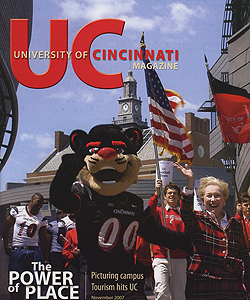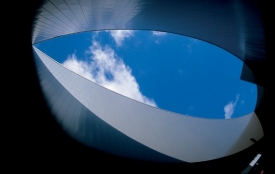Beyond the buildings and outside the physical boundaries of UC, there flourishes a less visible, though crucially important, campus community -- a place where visitors log in as opposed to walk onto campus.
It is here that UC's leading-edge technological architecture is allowing students, faculty and staff to gather and commune in a whole new way. What follows are a few examples of UC's endeavors to further develop its digital landscape:
Campus unplugged
UC is making good on its commitment to create a comprehensive wireless environment. The move will eventually cut the cords to landlines and data jacks campus-wide.
By fall 2007, in a continuing partnership with Cincinnati Bell, the university provided Bearcat Phones to thousands of incoming resident students. In addition to personal communication, these smart phones allow mobile access to Blackboard (UC's course-management software program) shuttle bus tracking, academic alerts and the university's police department.
Wi-Fi hot zone As part of the effort to unwire the entire campus, UC has created the largest Wi-Fi hotspot in Ohio. Guests who visit UC's Uptown Campus and surrounding neighborhoods can now enjoy the same wireless Internet access available to students, faculty and staff. Laptop toting visitors receive a free three-day connection.
Learning from a distance UC regularly graduates students each year who have never set foot on campus and complete their entire degrees taking online courses. The university offers numerous distance-learning degrees at the associate, bachelor's and master's levels.
Bearcat Chat UC's admissions staff hosts a two-hour online chat on Tuesday nights to answer common questions from new and future students about life on campus and admissions requirements.
Googling campus Virtual 3-D models of campus buildings are beginning to spring up in Google Earth's Web application thanks to the work of a group of DAAP students who took part in Google's "Build Your Campus in 3-D Competition." The UC team placed among the top 40 out of about 4,000 entries. Led by research associate Jose Kozan, a dozen architecture students spent 10 months using the 3-D software SketchUP to recreate UC buildings such as Wilson Memorial Hall, French Hall, Dabney Hall and the Engineering Research Center for Google Earthies to explore.
UC's Second Life UC has begun developing a presence in Second Life, a 3-D multi-user virtual online platform, that will allow visitors to explore a virtual campus or even take part in distance learning using an avatar or personalized animated character.
Related article:

 Issue Archive
Issue Archive